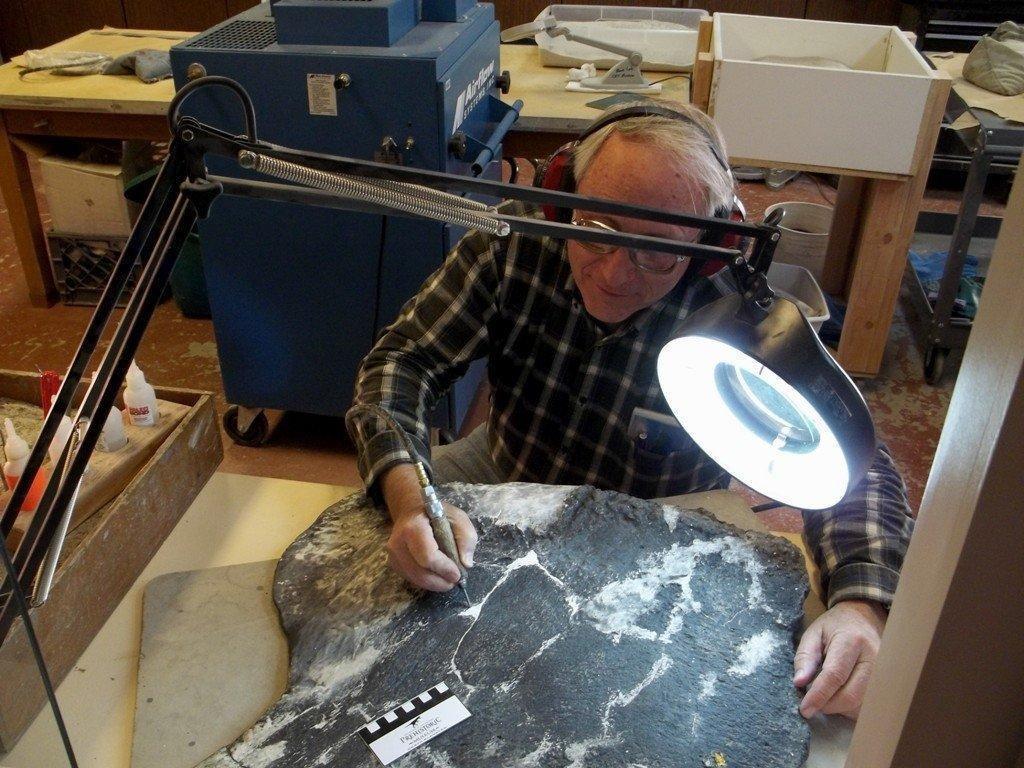The paleontology staff at the Utah State University-College of Eastern Utah Prehistoric Museum are currently working on a large fossil restoration project of the Cleveland-Lloyd specimens in “the pit”. Asked if they know how many fossils they will be working on,В Paleontology Lab Manager John Bird quipped, “No… We’re going to know after we finish though.”
It’s that sort of fun and lighthearted attitude that may surprise guests as they come in to see some of the work being done in the museum’s new paleontology observation lab, but that will draw them in to the world of dinosaurs as they see experts working on fossils that are more than 145 million years old.
The restoration project is one part of a much larger project Museum Director Ken Carpenter has initiated since he took over last year, to improve the overall experience of the museum, and to make patrons’ “education and museum experience more one-on-one.”
Bird and his colleagues, along with museum volunteers, are weeks into an expected two-year process of restoring fossils, which had been painted, or covered in shoe polish, to match replicas that are in the displays in the museum’s pit. Painting the fossils was common practice when they were acquired in the 1960s, according to Bird, but it is now custom to allow patrons to be able to see which bones are real and which are not.
The team is working on the fossils of a Camarasaur, a Stegasaur , and an Allosaur that have been mounted in the pit at the museum. They believe that approximately 35 percent of the bones are authentic, and they decide which are in a very simple way. “We pick them up,” said Bird. “The real bone is much more dense, heavier. The replicatedВ bone is lighter.”
This is because of the process through which the bones became fossils. As Bird explained, “The bones have been fossilized– or mineralized– meaning minerals have filled in the hollow parts of the bone. In doing that, instead of being lightweight like a bone is today, all of the holes that we might see in a cow bone today have been filled in with minerals, and the minerals are heavy.”
After making this determination, they remove the fossils from the pit and take them into the observation lab, where they remove any dust, and apply a thin layer of paint remover to the bone.
Having allowed the paint remover to sit on the bones for only about 10 minutes, they use soap and water to scrub the paint or shoe polish from the fossils. They then repeat the process on the other side of the fossil.
Though one might believe applying chemicals to the bones would be harmful, the staff is careful to only allow the paint thinner to stay on for a limited time, and as Bird explained, the fossils are strong. “Fortunately,” he said, “the bones are well preserved, so the paint remover doesn’t really affect them.
After removing the paint, they sometimes also need to remove some of the material used in the initial reconstruction of the fossils, to allow patrons to see as much of the real fossils as possible. Finally, they reapply any identifying information that was on the fossils and coat them with a liquid plastic, used to protect the bone.
“It’s a slow process,” Bird explained. “We’re only able to do a few bones each week, and so it’s going to take us a little while to finish this up.”
It is a fascinating process, though, that they invite the community to come and see at the museum. Bird invited, “We’ll be doing as much work as we can in this lab. It should be really fun to see.”
If you are interested in watching the paleontology staff restore the fossils, or just want more information, contact the USU-CEU Prehistoric Museum at (435)613-5060. But, if you are wondering how many fossils they will be restoring, ask them in two years.


